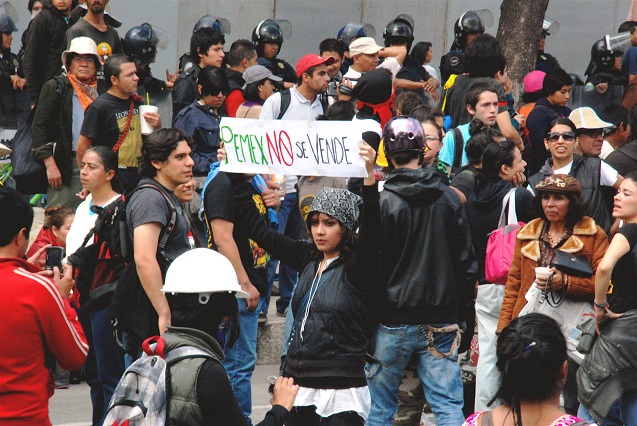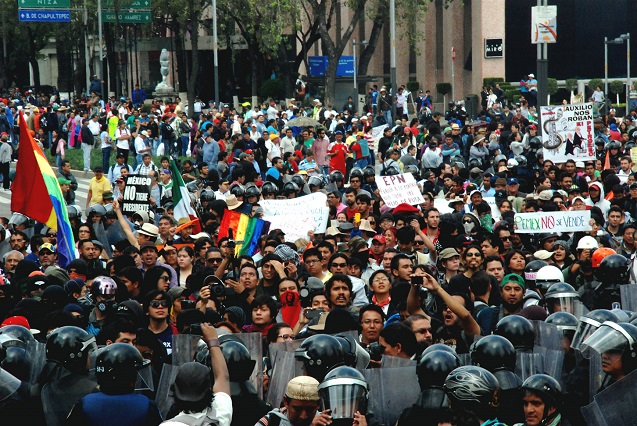
“Peak oil is not the same as running out of oil. What it means is simply reaching the ceiling, and then starting a terminal decline in oil production as determined by basic geological and technological factors.”
– Bellamy Foster 2011
Recently the president of Mexico, Enrique Peña Nieto, introduced an energy reform bill that would modify existing legislation to allow greater public and private investment in the energy sector. This would enable the exploitation of more complex oil deposits, including unconventional oil. The inspiration for the bill comes in part from the 9,100 drilling permits that the US has granted to 170 oil companies for oil and shale exploitation, in contrast to the three deposits that have been opened to exploitation in Mexico.
With 680 trillion cubic feet, Mexico ranks fourth in the world – after China, the United States and Argentina – in shale gas reserves, according to estimates by the US Department of Energy’s Energy Information Agency. These are resources that must be exploited, according to the reform measure.
Shale gas is extracted from soft sedimentary rocks formed by deposits of mud, silt, clay and organic matter. The two techniques used for extraction of this gas are hydraulic fracturing (fracking) and horizontal drilling. These techniques have caused great alarm because of the environmental hazards associated with each process’ dependence on the use of millions of cubic feet of water and potentially harmful chemicals. An investigation conducted by the Tyndall Centre argues that the processes not only affect underground and surface aquifers but also human health. For example, 17 of the chemicals used in the extraction of shale gas have been classified as toxic to aquatic organisms, 38 as acutely toxic and eight as carcinogens. An additional six are suspected of being carcinogenic, seven are mutagenic and five have reproductive side effects.
For some time, the United States has been concerned about reaching “peak oil” with regard to conventional oil production. For political and economic reasons, the United States has exaggerated its reserves, since an admission of the real amount would mean a worsening of the economic crisis that has permeated the global capitalist system. With only 4 percent of the world population, the US consumes 25 percent of global energy output. Two-thirds of the oil consumed is in the form of gasoline and diesel fuel for cars and trucks. Therefore, the peak of conventional oil production could cause a catastrophic collapse of the United States’ economy if it doesn’t have access to sufficient hydrocarbon energy to allow for time to convert its vehicle fleet and alter production chains.
Alan Greenspan, former chairman of the Federal Reserve, argues in his book The Age of Turbulence that the intervention in Iraq and the increased military presence in the Middle East were justified because “the last quarter century will require between one-quarter and two-fifths more oil than is used today.” The possibility of the end of cheap oil puts the US in a state of high alert. In the same vein, the Government Accountability Office, in a report published in 2007, argued that “the uncertainty about future oil supply makes it important to develop a strategy to deal with the peak and decline of the production of hydrocarbons.” Since the Bush administration, the United States has taken a more aggressive stance in controlling world production of hydrocarbons and biofuels, a part of which has been a wave of occupations and lootings.
Mexico figures into this strategy. During the presidency of Felipe Calderon, Greenspan said Mexico had to open its energy sector to foreign capital or it could set off a fiscal crisis. Several Mexican researchers, including John Saxe Fernandez of the National Autonomous University of Mexico, have refuted Greenspan’s assertion. Saxe Fernandez said Petroleos Mexicanos (PEMEX) generates sufficient resources to develop exploration and drilling not only in deep water but also on the continental shelf and in shallow water.
The problem, rather, is that the Ministry of Finance, hobbled by the dictates of the International Monetary Fund and World Bank – entities close to Mr. Greenspan – has launched a brutal attack on PEMEX, according to Saxe Fernandez.
“Between 1990 and 2004, PEMEX made $347 billion in profits (in 2004 dollars).The Ministry of Finance charged them $355 billion in taxes,” Saxe Fernandez asserted. “Besides confiscating 100 percent of the profits generated in that period, they charged them an additional $8 billion. The objective? In the words of the World Bank: ‘take the company to the point of sale.’ “
To illustrate how unusual PEMEX’s case is, consider the fact that in 2004 British Petroleum paid taxes that equaled 34 percent of its $24.7 billion profit. In the same year, PEMEX profits were $40 billion, but the Ministry of Finance charged it $42 billion. Saxe Fernandez claims the Finance Ministry, following the dictates of the World Bank and the IMF, is trying to force PEMEX into debt to cover these deficits, making it all the more vulnerable to sale.

For decades, the World Bank, IMF and Inter-American Development Bank have pushed for the imposition of such free-market reforms in Mexico and across Latin America, often through so-called SAPs, or structural adjustment programs. Such programs, executed by the secretary of finance, have facilitated transnational investment, unconventional oil development and other strategic areas such as clean energy, large-scale GMO production, biofuels, education and health. According to Joseph Stiglitz, winner of the Nobel Prize in economics and former vice president of the World Bank, SAPs have four steps:
Privatization: The government sells businesses and public institutions to private investors.
Liberalization of capital markets: Controls on money in and out of the country are reduced. To attract investors to the country, interest rates are greatly increased.
Introduction of market prices: The government gets rid of price controls, and commodity prices are dictated by the market.
Free trade: Barriers (taxes and duties on foreign goods) to protect local producers and industries are removed.
Thus, energy “reform,” along with “reforms” in educational, fiscal and financial sectors, is the center of gravity of the new strategy for economic development and growth in Mexico promoted by Peña Nieto.

Nevertheless, according to a national study conducted by Alianza Civica, more than 83 percent of Mexicans are firmly opposed to amending the Constitution to allow for private investment in the exploitation and processing of oil and gas in Mexico. They agree that this would have a direct impact on the 80 million poor Mexicans, especially considering that 40 percent of the country’s public expenditure (education, health care, infrastructure, security and social programs) is financed with PEMEX revenues. An immediate impact would be felt through a rise in basic food prices, which has been a principal driver of increasing poverty in Mexico. According to the National Council for the Evaluation of Social Development Policy, asset poverty is defined as the inability to purchase basic food items.
Predictions of economic growth and development spurred by the reform made by Peña Nieto and others don’t convince many Mexicans. For several weeks now, thousands of teachers from the National Coordinator of Education Workers (CNTE) have mobilized in the north, center and south of Mexico, demanding the repeal of recently passed education reforms supported by the Organization for Cooperation and Development, which has historically supported privatization. This has triggered discontent toward Peña Nieto and his structural reforms. It also has caused CNTE teachers to radicalize their actions and demonstrations, as well as increase solidarity with other unions and civil organizations in different sectors across the country that oppose the energy reform. Meanwhile, the state’s response has been to contain social protest with military equipment donated by the United States under the Merida Initiative, which originally was intended to combat organized crime. With more protests almost certainly on the horizon, it seems that Mexican civil society is in for continued United States-sponsored state repression.
Join us in defending the truth before it’s too late
The future of independent journalism is uncertain, and the consequences of losing it are too grave to ignore. To ensure Truthout remains safe, strong, and free, we need to raise $50,000 in the next 9 days. Every dollar raised goes directly toward the costs of producing news you can trust.
Please give what you can — because by supporting us with a tax-deductible donation, you’re not just preserving a source of news, you’re helping to safeguard what’s left of our democracy.